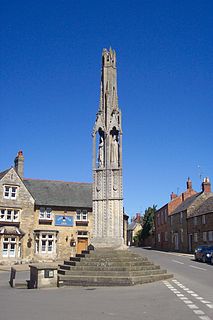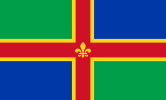Related Research Articles

The Battle of Lewes was one of two main battles of the conflict known as the Second Barons' War. It took place at Lewes in Sussex, on 14 May 1264. It marked the high point of the career of Simon de Montfort, 6th Earl of Leicester, and made him the "uncrowned King of England". Henry III left the safety of Lewes Castle and St. Pancras Priory to engage the Barons in battle and was initially successful, his son Prince Edward routing part of the baronial army with a cavalry charge. However Edward pursued his quarry off the battlefield and left Henry's men exposed. Henry was forced to launch an infantry attack up Offham Hill where he was defeated by the barons' men defending the hilltop. The royalists fled back to the castle and priory and the King was forced to sign the Mise of Lewes, ceding many of his powers to Montfort.

The Eleanor crosses were a series of twelve tall and lavishly decorated stone monuments topped with crosses in a line down part of the east of England. King Edward I had them erected between 1291 and about 1295 in memory of his wife Eleanor of Castile, who died in November 1290, marking the nightly resting-places along the route taken when her body was transported to London. The crosses stood at Lincoln, Grantham and Stamford, all in Lincolnshire; Geddington and Hardingstone in Northamptonshire; Stony Stratford in Buckinghamshire; Woburn and Dunstable in Bedfordshire; St Albans and Waltham in Hertfordshire; Cheapside in London; and Charing in Westminster. Three – those at Geddington, Hardingstone and Waltham Cross – survive more or less intact; but the other nine, other than a few fragments, are lost. The largest and most ornate of the twelve was Charing Cross.

The Foss Dyke, or Fossdyke, connects the River Trent at Torksey to Lincoln, the county town of Lincolnshire, and may be the oldest canal in England that is still in use. It is usually thought to have been built around AD 120 by the Romans, but there is no consensus among authors. It was refurbished in 1121, during the reign of King Henry I, and responsibility for its maintenance was transferred to the city of Lincoln by King James I. Improvements made in 1671 included a navigable sluice or lock at Torksey, and warehousing and wharves were built at Brayford Pool in the centre of Lincoln.
Robert Bloet was Bishop of Lincoln 1093-1123 and Chancellor of England. Born into a noble Norman family, he became a royal clerk under King William I. Under William I's son and successor King William II, Bloet was first named chancellor then appointed to the See of Lincoln. Continuing to serve the king while bishop, Bloet remained a close royal councillor to William II's successor, King Henry I. He did much to embellish Lincoln Cathedral, and gave generously to his cathedral and other religious houses. He educated a number of noblemen, including illegitimate children of Henry I. He also was the patron of the medieval chronicler Henry of Huntingdon, and was an early patron of Gilbert of Sempringham, the founder of the Gilbertine monastic order.

Lincoln Castle is a major Norman castle constructed in Lincoln, England, during the late 11th century by William the Conqueror on the site of a pre-existing Roman fortress. The castle is unusual in that it has two mottes. It is one of only two such castles in the country, the other being at Lewes in East Sussex. Lincoln Castle remained in use as a prison and law court into modern times, and is one of the better preserved castles in England; the Crown Courts continue to this day. It is open to the public most days of the week, and possible to walk around the walls from which there are views of the castle complex, cathedral, the city, and surrounding countryside. The castle is now owned by Lincolnshire County Council and is a scheduled ancient monument.

The Five Boroughs or The Five Boroughs of the Danelaw were the five main towns of Danish Mercia. These were Derby, Leicester, Lincoln, Nottingham and Stamford. The first four later became county towns.
Nicholas Farnham was a medieval Bishop of Durham.

Bardney Abbey in Lincolnshire, England, was a Benedictine monastery founded in 697 by King Æthelred of Mercia, who was to become the first abbot. The monastery was supposedly destroyed during a Danish raid in 869. In 1087, the site was refounded as a priory, by Gilbert de Gant, Earl of Lincoln, and it regained status as an abbey in 1115.
Michael David Knowles was an English Benedictine monk, Catholic priest, and historian, who became Regius Professor of Modern History at the University of Cambridge from 1954 to 1963. His works on monasticism in England from the times of Dunstan (909–988) to the dissolution of the monasteries are considered authoritative.

The Holy Trinity Priory, also known as Christchurch Aldgate, was a priory of Austin canons founded around 1108 by Queen Matilda of England, wife of King Henry I, near Aldgate in London. The queen received advice and help in the foundation from Anselm of Canterbury, the Archbishop of Canterbury. The house was founded with clergy from St Botolph's Priory in Colchester, and the first prior was Norman, who was the queen's confessor. By 1115 the entire soke, or liberty of East Smithfield was given by the Knighten Guilde to the church of Holy Trinity within Aldgate. The prior of the abbey was then to sit as an ex officio Alderman of London.

Beorhthelm is an Anglo-Saxon saint about whom the only evidence is legendary. He is said to have had a hermitage on the island of Bethnei, which later became the town of Stafford. Later he went to a more hilly area, possibly near Ilam, where he died. Beorhthelm (Bertram) of Stafford is venerated as a saint in the Eastern Orthodox Church, with a feast day on 10 August.

Torksey railway station was a station in Torksey, Lincolnshire on the line between Lincoln and Retford. It closed to passengers in 1959, but part of the line remained in use for freight traffic until the early 1980s. Torksey Viaduct remains as a Grade II Listed Structure.

Cottam railway station was a station in Cottam, Nottinghamshire, England which is now closed. Part of the route on which the station was located remains in use for freight trains serving Cottam power stations, although the line through to Saxilby and Lincoln via Torksey closed to passengers in November 1959.

Torksey Castle is an Elizabethan manor house located in the village of Torksey on the east bank of the River Trent in Lincolnshire, England. It is 12 miles northwest of Lincoln on the A156 road. Seven miles to the north is Gainsborough Old Hall and 10 miles southeast is Lincoln Castle. It is a 16th-century Tudor stone-built fortified manor house founded by the Jermyn family of Suffolk. It is a Grade-I listed building and a scheduled ancient monument but the building is on the Heritage at Risk Register. The site is private, with no public access and is only visible from the A156 road and a public footpath, on the west bank of the River Trent.

St Oswald's Priory was founded by Æthelflæd, daughter of Alfred the Great, and her husband Æthelred, ealdorman of Mercia, in the late 880s or the 890s.

St. Mary Magdalen was a Benedictine priory in Lincoln, England. Along with Sandtoft Priory and Hanes Cell, it was a Lincolnshire cell of St Mary's Abbey in York, England. A surviving building, once owned by the priory, is Monks' Abbey, Lincoln.
Torksey Nunnery was a nunnery in Torksey, Lincolnshire, England. It was founded at the south end of the town by the side of the Fossdyke. It housed a small community of Cistercian Nuns. Being appropriately dedicated to St Nicholas, the patron saint of sailors, it became known as the Priory of St Nicholas de Fossa, or the Fosse Nunnery.
Ruislip Priory was a priory in Middlesex, England. In 1086 or 1087 the manor of Ruislip was given to Bec Abbey by Ernulf de Hesdin. An administrative centre, it had a priory before 1200. In the early 13th century the administration of Bec's manors was shared with Ogbourne Priory in Wiltshire. As one of the alien priories, Ruislip shared their varying fortunes. Ruislip was always a manor-house rather than having conventual buildings. After 1404 the manors were reallocated, Ruislip going to St Nicolas College, Cambridge. St Nicolas College was later renamed King's College.
Sele Priory was a medieval monastic house in Upper Beeding, West Sussex, England.

The Littlemore Priory scandals took place between 1517 and 1518. They involved accusations of sexual immorality and sometimes brutal violence among the nuns and the prioress of Littlemore Priory in Oxfordshire. The Benedictine priory, which was very small and poor, had a history of troubled relations with its bishop. The scandal that came to light in 1517, however, became enough of a cause célèbre to contribute to the priory's eventual suppression in 1525. Katherine Wells, the prioress of Littlemore at that time, ran the priory with strict and often violent discipline. She was accused of regularly putting nuns in the stocks for extended periods, as well as physically assaulting them. She also had a baby by the priory's chaplain and had pawned the priory's jewels to pay for the child's upbringing. She entertained men in her parlour, even after the bishop had been made aware of the accusations, which involved heavy drinking. At least one other nun also had a child. On one occasion four nuns broke out of the priory through a window and escaped into the surrounding villages for some weeks.
References
- ↑ Hill, J.M.F. (1948). Medieval Lincoln. Cambridge University Press. p. 308.
- Hill, C. J.M.F., ed. (1948). Medieval Lincoln. Cambridge: Cambridge University Press.
Coordinates: 53°18′03″N0°44′41″W / 53.300891°N 0.744771°W
| This article about a Lincolnshire building or structure is a stub. You can help Wikipedia by expanding it. |
| This article about a British Christian monastery, abbey, priory or other religious house is a stub. You can help Wikipedia by expanding it. |

